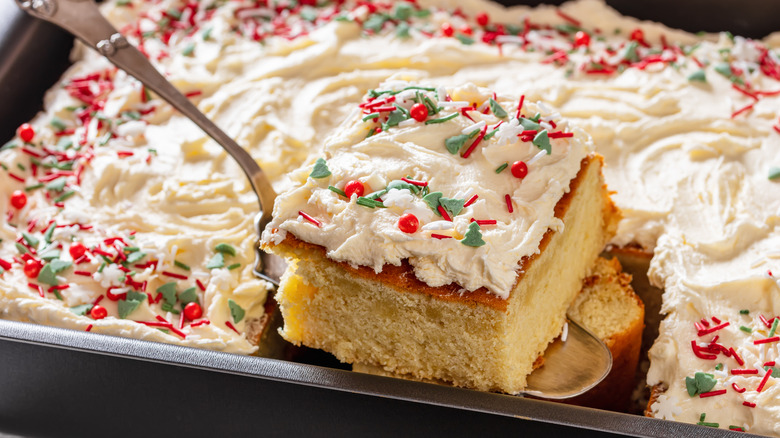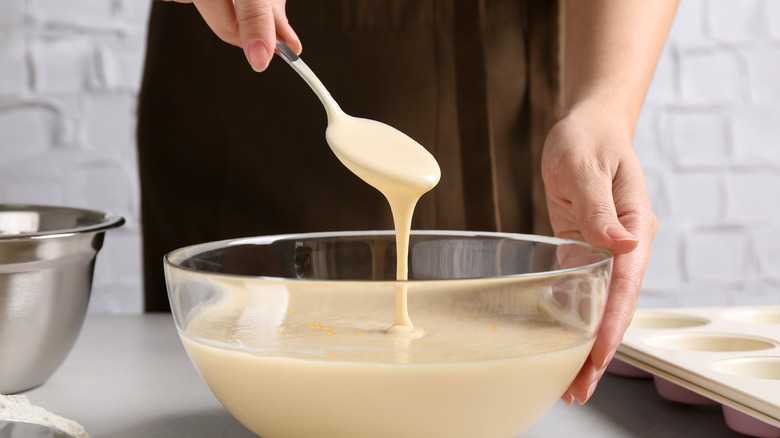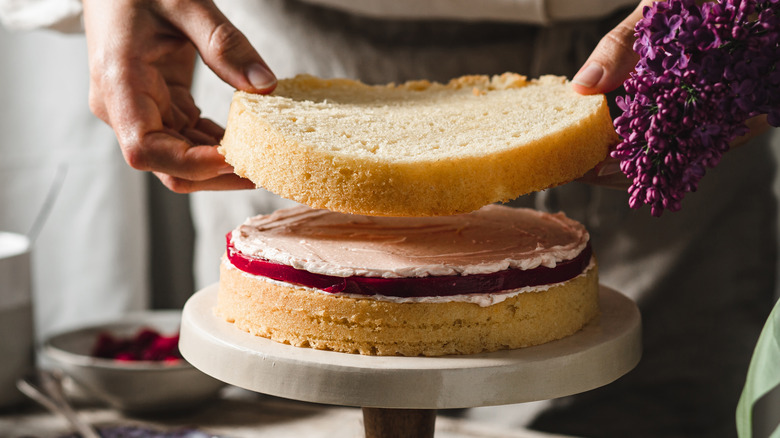The Ratio To Remember For Transforming A Layer Cake Into A Sheet Cake
So you've just mastered the art of creating a towering layer cake, but now you're being asked to replicate that same deliciousness in a single layer. Transforming a layer cake into a sheet cake opens up new possibilities for presentation and customization, sure, yet it can be difficult for those who don't excel at math or measurements. Simply doubling or halving the recipe may not yield consistent results, leaving you with a lopsided cake or a dry crumb.
If that's you: There's no need to stress about converting your beloved layer cake recipe into a crowd-pleasing sheet cake. As any seasoned baker knows, ratios are the secret to successful baking. They ensure that the ingredients are in the right proportions to yield a perfectly moist, flavorful cake every time.
And when it comes to making a sheet cake, the ratio you need to know is simple: The recipe for a two-layer cake baked in 9-inch round pans can be used for a cake baked in a 9-by-13-inch rectangular cake pan. So why stick to small, round cakes when you can up your game with a bigger, bolder sheet cake? Read on for tips and tricks to make your next sheet cake a sweet success.
Tips for converting a layer cake into a sheet cake
You don't need any additional ingredients to convert a layer cake into a sheet cake (unless you want to add extra ingredients; Ree Drummond doubles the butter for her sheet cake simply because it adds moisture and flavor). Instead, the key is mastering and sticking to the ratio.
King Arthur Baking specifically points out that what you're really looking for is a recipe that calls for 6 cups of batter, as that amount fits perfectly when poured into a 9-by-13-inch pan. So, regardless of the size or shape of the pan, if it totals 6 cups of batter, you should be fine.
They also point out that because the surface area of a rectangular sheet pan is different than a 9-inch round pan, you'll need to add some time to the timer while baking. When converting the original two-layer cake recipe to a 9-by-13-inch sheet cake, you'll want to bake it for 20 to 25% longer and keep an eye on the cake as it bakes (all ovens cook slightly differently, after all).
When it comes to frosting, the amount for a two-layer cake should be enough to cover the single-layer sheet cake, but measuring out 3 cups should provide you with more than enough to frost and decorate your dessert. However, it'll be easier to frost a sheet cake with a smaller offset spatula than the larger offset spatula you'd use to frost a layer cake.
Flipping the script: What if you only have a sheet pan?
Don't have a set of round cake pans but still want to make a delicious layer cake? This hack works both ways. With just a 9-by-13-inch sheet pan, you can follow the recipe as usual, making your batter base with the same ingredients, and baking it in your sheet pan. Then, use an upside-down plate as a guide to cut circles out of your sheet cake. This trick may not produce perfectly shaped layers, but with a bit of trimming, they will look and taste just as fantastic.
If you're using a standard 9-by-13-inch sheet pan, your cake rounds might have to be slightly smaller, but if you happen to have a 13-by-18-inch pan at your disposal, the cake should be big enough for you to cut at least three 6-inch round cake layers. Sure, you'll end up with excess cake, but the leftover crumbs can be used as decoration or creative mix-ins in another dessert (try using them to make cake pops, for example).
This method can be a lifesaver when you're in a pinch and don't want to invest in yet another set of baking pans. So go ahead and flip the script, and enjoy a delicious homemade layer cake or sheet cake baked in your rectangle pan — the recipe should be exactly the same.


